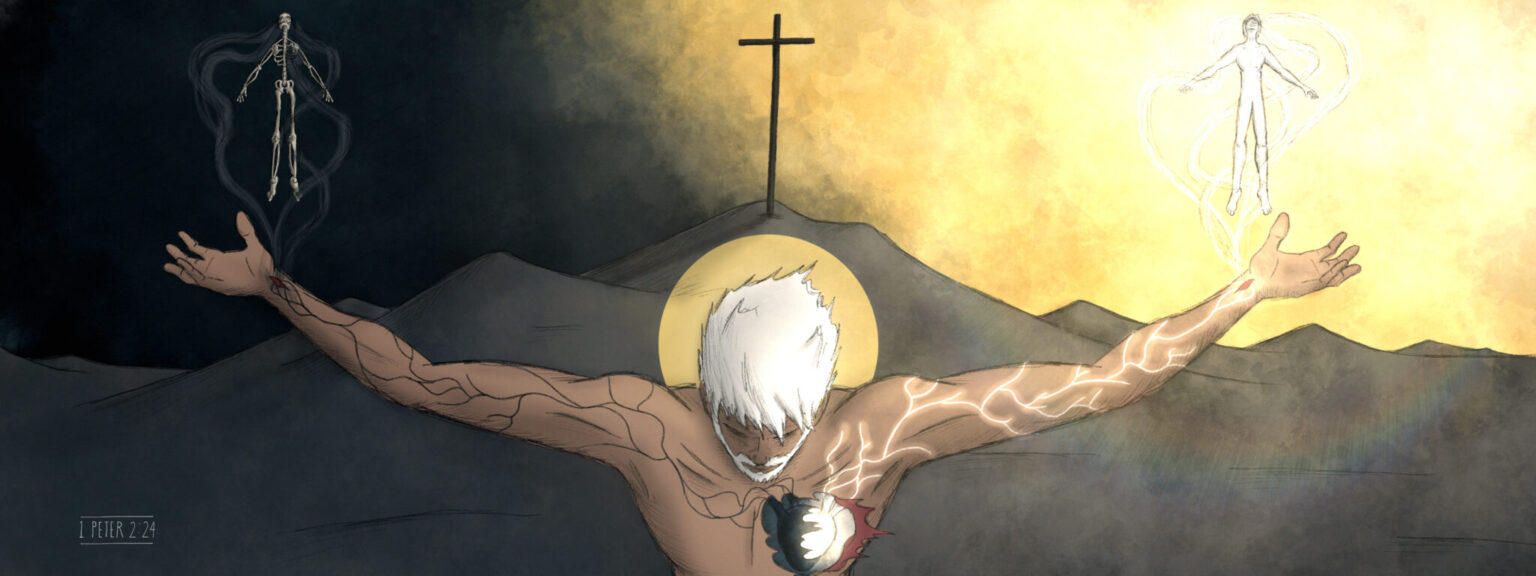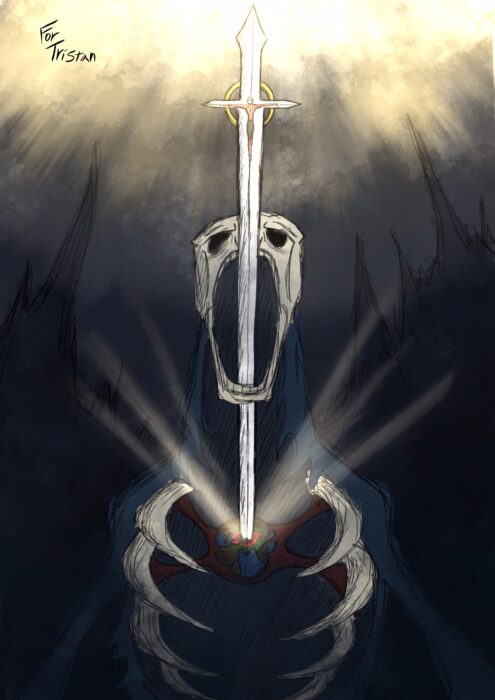For this final blog post dealing with the ministry of Full of Eyes itself, I want mention a few of the “special concerns” that I believe the Lord has given me for this work.
The Special Concerns of Full of Eyes
Christocentric
- Our art will maintain a special focus on the person and work of Jesus Christ, particularly His death and resurrection.
- We have arrived at this conviction because reality exists for the glory of God (Romans 11:36), and because the glory of God is His character and nature communicated (Exodus 33:18-19, 34:6-7), and because Jesus Christ is the flawless communication of God to creation (John 1:18, 14:9, 17:26, Colossians 1:15,19, Hebrews 1:3), and because all of reality will, one day, be summed up in God the Son (Ephesians 1:10).
- Paul’s ministry, by his own reckoning, could be summarized as a preaching of the unsearchable riches of Christ (Ephesians 3:8), or as knowing nothing but Christ and Him crucified (1 Corinthians 2:2), or simply as a proclamation of Christ (Colossians 1:28). It is, therefore, the conviction of the artists at Full of Eyes that the beauty and benefits bound up in the person of Jesus Christ are infinite, of great value to the artist and to the world, and worthy of our focused exploration, adoration, and communication. It is to this that we happily – should the Lord will – devote the remainder of our lives.
- The particular emphasis of Full of Eyes falls on the death and resurrection of Christ because we believe that scripture presents the crucifixion and resurrection of Jesus as the core of His glory.
- It is in His dying and rising that God the Son reconciles the creation to God and the upholds His Father’s glory and righteousness (Colossians 1:19-20, John 12:27-28, 13:31-32, 17:1 Romans 3:23-26).
- It is through His conquering death that He is installed as universal King and granted the authority to close redemptive history (Matthew 26:64, Hebrews 2:9, Revelation 5:9).
- And it is as the slain-yet-living Lamb that Christ will eternal make the invisible God known to His redeemed people (Revelation 5:6,22:3-4).
Evangelistic
- Our art is created with the intent to bring the viewer to faith in, love for, and obedience to the Lord Jesus Christ.
- To that end, much of our art will contain elements of – and often the entirety of – the gospel of the glory of Jesus Christ.
- We define “the gospel” as:
- The Good News that God the Son has come in the flesh (John 1:1,14), died for our sins, was buried, that He was raised bodily on the third day, (1 Corinthians 15:3-4) that He ascended to heaven (Luke 24:51) and now reigns until His impending and glorious return, (1 Corinthians 15:24-25) and that forgiveness of sins and a right standing with God is available freely to all who would turn from their sins and trust in Him as their beloved Lord and Savior (John 3:16, 6:37-40, Acts 2:38, 4:12).
- For those who are already enjoying an abiding relationship with Jesus Christ, our prayer is that our art would serve as a fresh sight of Christ’s glory in salvation and stir them up to greater faith and obedience and worship.
Biblical
- Our art will strive to be rigorously biblical “Aesthetic Exegesis.”
- By “Aesthetic Exegesis,” it is meant that our art will strive to be a faithful unfolding of the author’s (both divine and human) original intent – in a visual form. Just as the preacher must faithfully exegete a passage and then work to shape that truth into a message, so too we seek to faithfully exegete the scripture’s meaning and then work to mold that meaning into a pictorial communication of the same truth. As stated above, images are not words and so will never perform the same function as writing and preaching, however the function they do perform is a valuable one (see more on that function below).
- We will seek to communicate only what can be clearly understood from God’s word, and take care not to communicate false teaching – intentionally or unintentionally – through our work.
- To that end, we should have a verse, passage, or biblical teaching in mind with which to explain or defend anything we have communicated through our work.
Affectional
- Our art will seek to stir affections that are in accord with the truth being communicated.
- Puritan pastor Jonathan Edwards once said, I should think myself in way of my duty to raise the affections of my audience as high as possibly I can, provided that they are affected with nothing but truth, and with affections that are not disagreeable to the nature of what they are affected with.” In other words, the affections (ie, emotions) should be raised to a level that fits the topic being expounded
- (For example, weeping while a phone book is read would be an expression of emotion not fitting the topic. However, weeping at the end of a war or the news of a great loss is a fitting expression of emotion).
- The artists at Full of Eyes are in agreement with this sentiment and seek to use the medium of art as a means of stirring up affections in people’s hearts that are fitting for the content being communicated. We want people to cry over the gospel, so long as those tears are evidence of a Spirit-wrought glimpse of the glory of Christ.
- Art is a unique medium for the stirring of affections.
- We seek to stir the affections of both the believer and the unbeliever. For the unbeliever, our hope is that the beauty of Christ – even dimly reflected in our art – would be evangelistic. In his book Chasing Francis, Ian Morgan Cron observes that “all beauty is subversive,” and that “when the front door of the intellect is shut, the back door of the imagination is open.” The art of Full of Eyes seeks to storm that back door with the beauty of God in the face of Christ, and then to convince the intellect that He is not just beautiful, but unshakably true.
- We also seek to stir the affections of believers. CS Lewis once observed that affections for God and for Christ can begin to feel like a burdensome Christian obligation. In this situation, he saw fantasy literature as a way to “steal past the watchful dragons” and communicate the visceral potency of our religion to the dulled heart. In the same way, we hope that our art would be used by the Spirit to evoke fitting emotions in viewers’ hearts so that, without even knowing it, their affections would begin to sincerely rise for Christ – who is worthy of our highest affections.
- However, it needs to be said that the dangers of emotional showmanship are severe.
- Emotion for emotion’s sake is not what we are seeking. The affectional response of our own hearts as artists or of our viewers’ hearts should never be the goal. Rather, the goal is to rightly see the glory of God in Christ and to rightly expound that glory, trusting that when this is done faithfully, the Spirit will give the fitting affections.
- To that end we must be desperate in prayer, asking the Lord to keep our own eyes and heart open to and moved by his glory so that we might create organically moving work that is not merely an “emotional whip cream” or “evangelical kitsch.”
- Puritan pastor Jonathan Edwards once said, I should think myself in way of my duty to raise the affections of my audience as high as possibly I can, provided that they are affected with nothing but truth, and with affections that are not disagreeable to the nature of what they are affected with.” In other words, the affections (ie, emotions) should be raised to a level that fits the topic being expounded
Well, that concludes the blog posts that deal with the philosophy and foundations of Full of Eyes. From here on out I hope to be sharing shorter thoughts from scripture as well as updates on what God is doing through the ministry.




